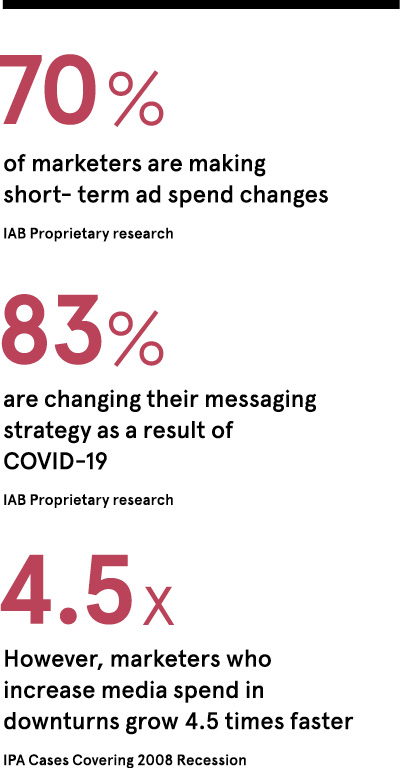Business-to-business (B2B) brands are going through an extraordinarily difficult time during the coronavirus pandemic, but can benefit from studying successful strategies implemented in previous downturns. Though the immediate temptation may be to cut advertising spend, a more measured approach may in fact be to hold or increase budgets to grow long-term market share.
In a survey by Marketing Week, 86 per cent of marketers said they are delaying or reviewing campaigns in light of the COVID-19 outbreak. But research from the B2B Institute, a think tank funded by LinkedIn, which examined different approaches from advertisers during the 2008-9 recession, suggests cutting advertising budgets is riskier than it may appear. Although cutting advertising may provide short-term relief to profitability, the subsequent loss of market share is costly to recover and thus puts long-term profitability in doubt.
“If you can afford to advertise, you should advertise,” says Jon Lombardo, global lead of the B2B Institute. “A lot of people don’t realise it’s cheaper and more effective to advertise right now. You can get a lot more media for the same price you were willing to pay six months ago. So assuming you can still meet demand, you get more bang for your buck.
“Typically, with an advertising campaign, you can hope to gain one or one-and-a-half points of market share per year. In times like this, you may be able to win up to four-and-a-half points of market share. In fact, both sales and market share responsiveness to advertising can be even stronger during a downturn than in normal times. Partly that’s because competitors often cut advertising spend, creating a unique window to increase relative share of voice and win market share.”
B2B brand associations created now are likely to bring the greatest sales benefit during the recovery period, precisely when the rewards are biggest
Driving emotional connections
It’s not just about the cost of media, marketers are also concerned about audience response to creative. Worst still, they fear consumers will react angrily to the mere existence of an advertising campaign, offended by what they deem to be profiteering and opportunism.
Recent data from System1, which measures consumer responses to new ads on a daily basis, shows no change in how consumers are responding to ads during the pandemic. The market research firm has seen no signs of ads alienating consumers, in part because the economic damage has been driven by an enforced, not elective, decline in consumption.
To the contrary, research from System1 for the B2B Institute found there is still opportunity for brands to connect with audiences. The impending recession is unusual in that a common enemy – COVID-19 – is generating a global community spirit unseen in previous downturns. Given the rise in community spirit, companies that demonstrate humanity, generosity and warmth in their advertising are more likely to build stronger customer and community relationships.
In addition, brands that incorporate established characters, such as Compare the Market’s meerkats, are performing particularly well, as people take comfort in familiarity during the hugely unfamiliar experience of crisis lockdown. B2B firms less able to leverage characters have instead seen success in campaigns celebrating human connections.
“The human connection ads may be a little less fun than character ads, but they have a warmth and a connection to real places, which resonate with audiences, and is really valuable in these times,” says Lombardo. “Humans are starved of connection at the moment, so they like to see people coming together.”
Restoring the balance
COVID-19 has given B2B organisations the rare opportunity to stop and reflect on their business and strategy. The trend for a long time now has been to invest more in short-term sales activation, which can often hurt companies. But the pandemic may lead to a greater number of brands, outside of the familiar names in sectors such as fast-moving consumer goods, retail and travel, realising the business value of increasing their focus on brand advertising.
“Because the sales funnel in B2B purchasing is generally longer than in business to consumer (B2C), the arguments in favour of supporting long-term growth through brand building are likely to be even stronger in B2B than B2C,” says advertising strategy guru Peter Field, who worked with the B2B Institute on its research. “B2B brand associations created now are likely to bring the greatest sales benefit during the recovery period, precisely when the rewards are biggest.”
Restoring the balance between long-term brand building and short-term sales activation during this downturn, by investing more heavily in brand advertising, will serve companies well in supporting future cash flows. There will be more recessions and B2B brands need to understand the playbook doesn’t necessarily change. In fact, maybe it stays the same and those who run that same playbook in future recessions will really help their businesses succeed.
For more information please visit B2Binstitute.com/allweather
